Empowered Learning in Games (7384)
Empowered Learning in Games (7384)
Yupei Duan
University of Missouri
Author Note
Yupei Duan, Ph.D. student at the School of Information and Learning Technology, University of Missouri.
This practice is one of the assignments of 2023FS-IS_LT-7384-01 Designing Games for Learning
Contact: yupei.duan@mail.missouri.edu
Mentor Game Details
I picked Predynastic Egypt(“Predynastic Egypt,”) as my first mentor game, which is a turn-based historical simulation strategy game. It is designed to lead the players to travel back to 7000 years ago to establish an empire according to unite the tribes, villages, and cities in ancient Egypt, starting from a couple of hunters and collectors. Clarus Victoria is the game developer an independent game development studio from Russia(Clarus Victotia Official Website). The game’s target audience should be older than primary school students who need to be equipped with basic reading abilities.
Hundreds and thousands of years passed in a couple of hours. My learning experience was impressive. It seemed like I was in charge of a country. As a curious and novice country governor, I conducted a lot of trials and errors with the sacrifice of life, resources, and time. This is also a good opportunity for me to check my ordinary life with similar thoughts in the game. For example, I am a new Ph.D. student in the USA, which is a totally different life from mine in China. I need to explore while keeping my safety as the first priority. Then, how do I manage my time and energy while holding many different hats at the same time: I have 9 credits of courses, I am a Graduate Research Assistant working on two different projects, I am a father, a husband, and a son…How to budget my time and money? How do we do things more efficiently? How do I keep myself on the right track to reach my main goals? They are all exactly similar thinking skills and strategies I can polish in the game. I am living my valuable life just like playing this valuable game.
The game gave me a lot of knowledge related to the history, religion, civilization, and geographical features of Ancient Egypt. The players can also use it to train their management skills and calculation ability. The game’s final objective is the unification of Lower and Upper Egypt. The players must carefully calculate how to distribute the workers, think about which actions should be taken when natural disasters happen, ponder which strategy would be the most proper when the adhered troops offense, etc. As a solo game, Prehistoric Egypt depicted an authentic scene of Ancient Egypt tribes, it showed the resources a tribe in need, a development goal that drove the whole tribe to be boomed, a bald heart, a game player wants to be a manager should have. The players will need to manage all the items and people he or she has wisely in the game in each turn. The players will have enough time to think about the actions they need to do between two turns. The game doesn’t have a time-counting function. The beautiful background music and neat action sound help the players immerse.
I didn’t find any specific associated materials with this game, but I saw there were many articles that introduced the game’s complete achievement guide while introducing Ancient Egypt’s history and civilization very detailedly(Predynastic Egypt – Complete Achievement Guide). The related instructional or learning materials could be made based on them.
Gameplay Experience
My limited understanding of Ancient Egypt came from my middle school World History course and movies like The Mummy Returns. This game gave me another change to go back to the Ancient Egypt. I used around 5 hours to go through the whole game in the first round, which was 220 turns in total.
The game hooked me for the first time, and it cost me more than four hours to explore and do experiments. Hundreds and thousands of years passed in a couple of hours. My learning experience was impressive it seemed like I was in charge of a country. As a curious and novice country governor, I conducted a lot of trials and errors with the sacrifice of life, resources, and time. This is also a good opportunity for me to check my ordinary life with similar thoughts in the game. For example, I am a new Ph.D. student in the USA, which is a totally different life from mine in China. I need to explore while keeping my safety as the first priority. Then, how do I manage my time and energy while holding many different hats at the same time: I have 9 credits of courses, I am a Graduate Research Assistant working on two different projects, I am a father, a husband, and a son…How to budget my time and money? How to do things more efficiently? How do I keep myself on the right track to reach my main goals? They are all exactly similar thinking skills and strategies I can polish in the game. I am living my valuable life just like playing this valuable game.
On its surface, gamification is simply the use of game mechanics to make learning and instruction more fun. It seems “fake” artificial or like a shortcut. It’s not. Underneath the surface is the idea of engagement, story, autonomy, and meaning. Games give experiences meaning, they provide a set of boundaries within a “safe” environment to explore, think and “try things out.” Games provide motivation to succeed and reduce the sting of failure(Kapp, 2012, p. 21).
I just had minimal accomplishments in my first round. I didn’t use a lot of time to accomplish the game’s main goal, but I did a lot of trial and error to explore the virtual world. I was not aware of the struggles in the game, and everything was smooth.
When I reviewed this game, I thought there were some possibilities to increase learning opportunities by playing. For example, some background knowledge could be distributed to the learners before the game to let them understand the basic knowledge about the world 7000 years ago, e.g., the religions of the local people, the common terminologies related to ancient Egypt… Besides that, a handout listed clear learning goals and a detailed guide could be helpful to the learners who other elements of the game could easily abstract, but not related to the instructional objectives.
Principles of Learning
Prof. Jim Gee pointed out three different categories of principles on gaming(Chris Thorn, 2013). In the game Predynastic Egypt, I found it contained the following principles:
Category one: Empower Learners
- Co-design. The players can select the choices to continue their ancient Egypt story.
- Customization. The play’s name (or nickname) will be shown in the game.
- Manipulation. The player is creating his or her own country.
Category two: Problem-based Learning
- Pleasantly frustrating. I failed in the first round but knew the game rules better and would like to try again to reach my main goals in the games.
- Just in time and on demand. The hints were the friendly guide to continue the game. The buttons the player should press were highlighted on each step.
- Fish tank. Initially, there are just a few elements, and the number of elements will rise while the players are getting more and more familiar with the game setting.
- Sandbox. Safe but feel dangerous when the attacks happen.
Category three: Deep understanding
- System thinking. Like governing an actual county, it is a system that needs system thinking.
- Situated learning. The game brought me to Ancient Egypt 5000 B.C.
Player Type
The reason why I selected this but not the others is that Prehistoric Egypt fits my game-playing preferences perfectly. As an explorer, I love the games that contain more Alea (Chance) and Mimicary (Simulation or Role Play) as Caillois’ Patterns of Play introduced to me(Kapp, 2012, p. 211).
The past two weeks were fantastic for me, both for my real life and for my game life. Games are the ideal learning environment with built-in permission to fail, encouragement of out-of-box thinking, and a sense of control.
Four years ago, I started my virtual learning journey at the School of
Information Science and Learning Technologies as a master’s degree pursuer. I
experienced the virtual learning environment at Townsend Hall as a game. Now, I
am an on-campus Ph.D. student who can sit in Townsend Hall physically to meet
the elite staff and faculty at SISLT, which is another game for me. I want
to continue my games.
References:
Chris Thorn (Director). (2013, November 13). Jim Gee Principles on Gaming. https://www.youtube.com/watch?v=4aQAgAjTozk
Clarus Victotia Official Website. (n.d.). Clarus Victoria. Retrieved September 5, 2023, from https://clarusvictoria.com/
Kapp, K. M. (2012). The Gamification of Learning and Instruction: Game-based Methods and Strategies for Training and Education (1st edition). Pfeiffer.
Predynastic Egypt. (n.d.). Clarus Victoria. Retrieved September 5, 2023, from https://clarusvictoria.com/predynastic-egypt/
Predynastic Egypt—Complete Achievement Guide. (n.d.). Retrieved September 5, 2023, from https://gameplay.tips/guides/9556-predynastic-egypt.html
Read MoreMy Style of Game Play and Exciting Experience with the First Mentor Game
Time flies, indeed, and especially when you are immersed in a video game you love. Additionally, if the video game was one part of your assignment, then you have solid reasons and 100% confidence to play it on time. I always procrastinate, but I didn’t procrastinate so much this time. I am the lucky person who had a video game assignment in the Designing Games for Learning course guided by Dr. Danielle Oprean, assisted by a game Champion, Arch McGee, from Why So Serious Game (WSSG) Academy.
Know Yourself
“Know thyself” (Greek: Γνῶθι σαυτόν, gnōthi sauton) is a philosophical maxim which was inscribed upon the Temple of Apollo in the ancient Greek precinct of Delphi(“Know Thyself,” 2023).

As a designer and researcher of gamification, I want to observe video games from higher dimensions than ordinary players. I was an ordinary player before this course. As a naughty boy who grew up in China, video games had more lure than candies to me, which my parents strictly forbade. But I was still crazy curious and addicted to playing them when my parents did not have enough energy to supervise me (I can understand my 7-year-old daughter Ritang better when she tends to play with her iPad for a longer time without my and her mom’s supervision). I played Super Mario Bros and Contra throughout my primary school and middle school. I spent a lot of time playing Command & Conquer: Red Alert, StarCraft, Uncharted Waters, Diablo II: Resurrected, etc. when I was studying in High School. Then, online games became more and more popular when I enrolled in college, and the World of Warcraft “murdered” a lot of my spare time… I even became addicted to online video games in the fall semester when I was a sophomore, which resulted in my two failed courses… After that, I spent a long time pondering the pros and cons of video games, and I noticed the importance of time management skills and effective learning. Day by day, I rescheduled my learning time and playing time and tried to choose the proper games to align them with my learning. For example, I used the Age of Empire series to experience different languages and civilizations and learn world history. I even used some games in my biology and science courses after I graduated from college and became a teacher. I also like the friendly and easy atmosphere when people play video games, and I thought the constructive learning progression is similar to the learning progression when I can use game-style activities properly. So, I love video games, especially those that bring me new knowledge and feelings.
Dr. Oprean shared with us a tool to test my Game Play Type: Quantic Gamer Motivation Survey The survey told me that I was both an Architect and a Bart.

I think the gamer profile matches me well. I love games that can broaden my horizons, extend my life, enrich my feelings, and touch my inner heart. The profile told me that my primary player type is the “Architect,” who tends to play games independently, make decisions, and enjoy the progression. I truly enjoy the feeling of establishing projects and achievements in the games. Meanwhile, the profile uncovered my secondary player type, the “Bard,” who is also good at passionately interacting with team members to explore the fantasy world. Playing video games is one of my ways of socializing. I have some lifelong friends who share similar memories of playing video games together.
My Game Player Type
If someone askes me to choose one game I love most, that will be Uncharted Waters IV.

This is a simulation and role-playing video game dealing with sailing and trading, themed around the Age of Discovery. By the way, Treasure Island and Robinson Crusoe were my favorite novels when I was studying in high school. High school was the period for me to play video games most frequently, so the game gave me a very deep impression. As a player in Uncharted Waters IV, I can take the role of a captain to manage a seagoing fleet to trade, hunt treasure, be a privateer, conquer the world, or travel all over the planet. During the procedure, romantic plots and sagas happened. I even learned the world history and geology while playing this game. The impressive and touching storylines in the game made me cry and laugh. Sometimes, it was hard to tell the difference between my illusion from the game and my daily life. Even right now, when I type these words, my heart bumps much faster with recalling the details of the game.
Karl M. Kapp introduced one often-cited classification of player types created by Richard Bartle, a well-known figure in the gaming industry, who classified four different play types: Killers, Achievers, Socializers, and Explorers(Kapp, 2012, p. 204). I am an explorer who always tries to find out as much as I can about the game environment. For example, in my favorite video game Uncharted Waters, my goals were to explore all the nooks and crannies of that simulation world.
The First Mentor Game I played
Let’s go back from my view as an ordinary player to a higher dimensional viewer as a gamification designer and researcher. I picked Predynastic Egypt as my first mentor game, which is a turn-based historical simulation strategy game.
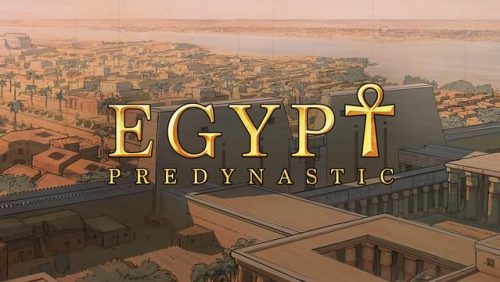
It is designed to lead the players to travel back to 7000 years ago to establish an empire according to unite the tribes, villages, and cities in ancient Egypt, starting from a couple of hunters and collectors. The reason why I selected this but not the others is that Prehistoric Egypt fits my game-playing preferences perfectly. As an explorer, I love the games that contain more Alea (Chance) and Mimicary (Simulation or Role Play) as Caillois’ Patterns of Play introduced to me(Kapp, 2012, p. 211).
In the past two weeks, I didn’t have time to try my second mentor game, 80 Days. The Predynastic Egypt occupied me for more than 4 hours in the first round when I realized. My limited understanding of Ancient Egypt came from my middle school World History course and movies like The Mummy Returns. The game gave me a lot of knowledge related to the history, religion, civilization, and geographical features of Ancient Egypt. The game’s final objective is the unification of Lower and Upper Egypt. The players need to calculate carefully how to distribute the workers, think about which actions should be taken when natural disasters happen, ponder which strategy would be the most proper one when the adhered troops offense, etc. I was not a good game player, I missed the mainstream to build a great and harmonious Egypt but focused on the detailed data of workers, food, production, army, culture, and authority. I finally realized that I had cruised away from the main storyline so far when there were just 10 turns left.
Reflections on playing my First Mentor Game
- The interrelationship between different elements in the game
During the whole process of playing the game, I could feel the Prehistoric Egypt was a holistic system. A game is a system in which players engage in an artificial conflict, defined by rules, that results in a quantifiable outcome(Kapp, 2012, p. 41).”

Initially, I noticed myself playing the game from a game designer and researcher’s view, but I became immersed in the game deeper and deeper as a purely joyful player. I totally forgot my higher goals eventually. The elements in the game worked together to show me a vivid ancient Egypt, not merely relying on the background music, the user interface, and the feelings when I touch the screen, but the interrelationship between all the elements. The figures introduced me to the history and civilization of ancient Egypt, and the algorithm encouraged and guided me to play more and more…
2. The craft and the actual value of gamification
On its surface, gamification is simply the use of game mechanics to make learning and instruction more fun. It seems “fake” artificial or like a shortcut. It’s not. Underneath the surface is the idea of engagement, story, autonomy, and meaning. Games give experiences meaning, they provide a set of boundaries within a “safe” environment to explore, think and “try things out.” Games provide motivation to succeed and reduce the sting of failure(Kapp, 2012, p. 21).

The game hooked me for the first time, and it cost me more than four hours to explore and do experiments. Hundreds and thousands of years passed in a couple of hours. My learning experience was impressive it seemed like I was in charge of a country. As a curious and novice country governor, I conducted a lot of trials and errors with the sacrifice of life, resources, and time. This is also a good opportunity for me to check my ordinary life with similar thoughts in the game. For example, I am a new Ph.D. student in the USA, which is a totally different life from mine in China. I need to explore while keeping my safety as the first priority. Then, how do I manage my time and energy while holding many different hats at the same time: I have 9 credits of courses, I am a Graduate Research Assistant working on two different projects, I am a father, a husband, and a son…How to budget my time and money? How to do things more efficiently? How do I keep myself on the right track to reach my main goals? They are all exactly similar thinking skills and strategies I can polish in the game. I am living my valuable life just like playing this valuable game.
3. The Jim Gee’s principles on Gaming I found
Prof. Jim Gee pointed out three different categories of principles on gaming. In the game Predynastic Egypt, I found it contained the following principles:
Category one: Empower Learners
- Co-design. The players can select the choices to continue their ancient Egypt story.
- Customization. The play’s name (or nickname) will be shown in the game.
- Manipulation. The player is creating his or her own country.
Category two: Problem-based Learning
- Pleasantly frustrating. I failed in the first round but knew the game rules better and would like to try again to reach my main goals in the games.
- Just in time and on demand. The hints were the friendly guide to continue the game. The buttons the player should press were highlighted on each step.
- Fish tank. Initially, there are just a few elements, and the number of elements will rise while the players are getting more and more familiar with the game setting.
- Sandbox. Safe but feel dangerous when the attacks happen.
Category three: Deep understanding
- System thinking. Like governing an actual county, it is a system that needs system thinking.
- Situated learning. The game brought me to Ancient Egypt 5000 B.C.
The past two weeks were fantastic for me, both for my real life and for my game life. Games are the ideal learning environment with their built-in permission to fail, encouragement of out-of-box thinking, and sense of control.
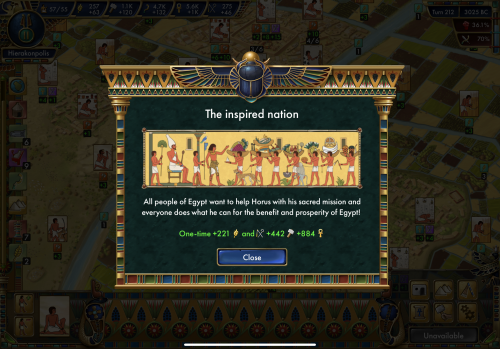
Four years ago, I started my virtual learning journey at the School of Information Science and Learning Technologies as a master’s degree pursuer. I experienced the virtual learning environment at Townsend Hall as a game. Now, I am an on-campus Ph.D. student who can sit in Townsend Hall physically to meet the elite staff and faculty at SISLT, which is another game for me. I want to continue my games.
References
Kapp, K. M. (2012). The Gamification of Learning and Instruction: Game-based Methods and Strategies for Training and Education (1st edition). Pfeiffer.
Know thyself. (2023). In Wikipedia. https://en.wikipedia.org/w/index.php?title=Know_thyself&oldid=1172237727
Read MoreMy Accomplishments at WSSG Design Academy
Here is page tracking my accomplishments at Why So Serious Game Design Academy.
Level 0
- Learned my way around Canvas’s features
- Examined the Syllabus
- Explored course-specific details about the WSSG Design Academy
- Identified the Required Textbook and Optional Books
- Reviewed the Mentor Game options
Level 1
- Select two mentor games
- Install and play one of my mentor games
- Learn about empowered learning in games
- Identify the type of player I am and learn how that impacts the games I play
- Explore how game elements present themselves in educational games

You have mastered the art of becoming the player, one who not only plays games for fun but is able to pay attention to what goes on to compare with other experiences. Play is a fundamental part of learning, while not all forms of play may be fun to every learner, that does not mean that learning is not occurring but that it may be occurring in a different way. Mastering this attribute means you have started on the path to understanding how to utilize this through being the learner.
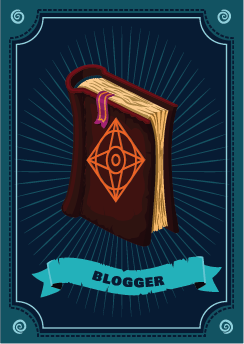
You have mastered the art of recording your thoughts and reflections in a meaningful way. Reflection is a powerful learning tool as it helps one establish and make connections beyond any course content by engaging with personal experiences. Mastering this attribute means you are ready to take on increasingly more complex problems to sort through by reflecting on your experience with them.
Level 2
- Developed game ideas
- Practiced developing stories complex enough for learning
- Formulated a learning objective
- Used Twine/Scratch to create a prototype
- Created my own Narrative Game Design
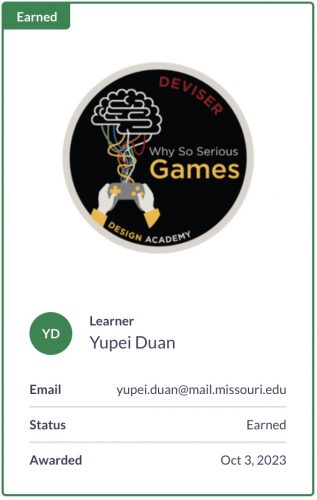
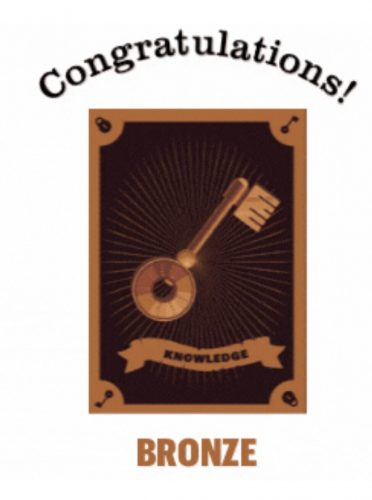
Bronze Knowledge Award. This is a basic level reward for Level. 2.
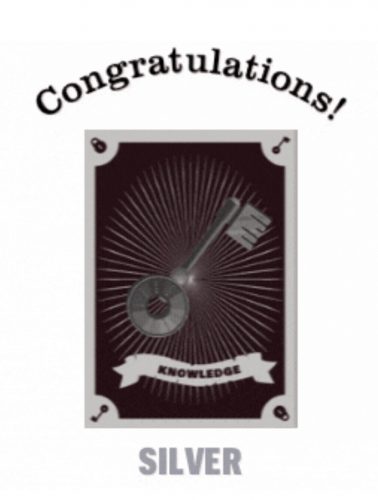
I’ve been awarded the silver knowledge attribute. This is an extra challenge, so I got extra points after the accomplishment.
Level 3
- Distinguished learning domains and how they function in serious games.
- Establish simple and complex mechanics that work best for intended learning objectives.
- Articulated gaming goals and core loops in serious games.
- Applied common game elements and game mechanics to game design to support learning.
- Provided feedback based on building learning in games and general game design to peers.
- Articulated a design for an analog game that addresses higher-order learning outcomes.
- Created an instructional guide for your analog game.
- Implemented paper prototyping of your analog game.
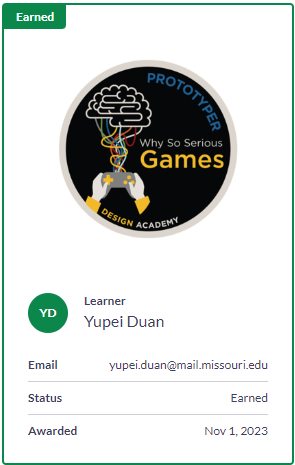

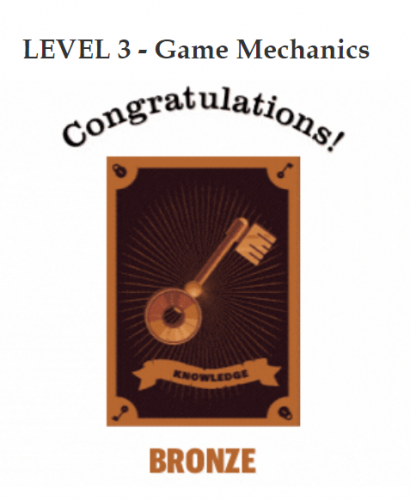


Mechanics are at the heart of every game; they fuel the interaction that players experience in order to progress and eventually win or lose. To earn the Ludology Attribute, you’ve proved yourself to be a true Ludologist (one who focuses on gameplay as the main driving force for a game over narrative) and were able to generate a core loop around the central mechanic of a game. But when working with serious games that are gameplay-driven, you also need to know where the learning happens. You’ve demonstrated mastery of this for serious games by aligning learning to the activities players perform.
Level 4
- Distinguished learning domains and how they function in serious games.
- Establish simple and complex mechanics that work best for intended learning objectives.
- Articulated gaming goals and core loops in serious games.
- Applied common game elements and game mechanics to game design to support learning.
- Provided feedback based on building learning in games and general game design to peers.
- Articulated a design for an analog game that addresses higher-order learning outcomes.
- Created an instructional guide for your analog game.
- Implemented paper prototyping of your analog game.
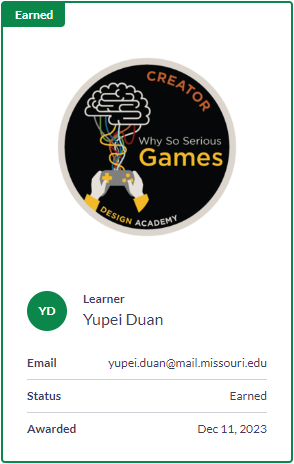
To earn the Creator Badge, trainees must complete the final project and post their completed designs to their blogs.
The end of the training is completed by creating a design document and key scene in a game engine.
Awarded for completing requirements in group 2023FS-IS_LT-7384-01: LEVEL 4 | Complete the Level

At the heart of learning how to design games for learning, you have focused your efforts on the construction of games. This entails not simply creating games but constructing them from knowledge across your training experience into a development tool, building an understanding as we go through analysis and evaluation. To earn the constructionist attribute, you have demonstrated you are capable of guiding yourself through learning the tools necessary to create digital learning games — game engines.
Level 5
- Applied my knowledge from previous levels on empowered learning
- Adapted my feedback into my design for the final submission
- Finalized my game prototype using Construct 3
- Created a pitch presentation of my revised game design

To earn the Designer Badge, trainees must submit initial design ideas or storyboards that include the educational component of achievements for assessing learning objectives within their game’s design.
Demonstrated the ability to design a digital game for learning. Earning this badge indicates that a trainee has made it through all the aspects of design that have been revisited to aid in the design of a simple digital game.
Awarded for completing requirements in group 2023FS-IS_LT-7384-01: LEVEL 5 | Complete the Level

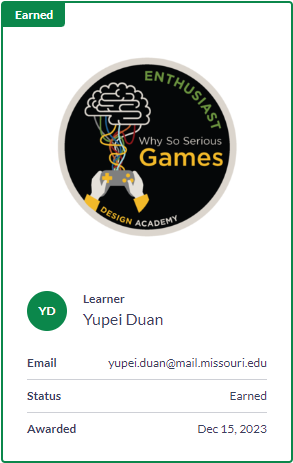
Evidence of all attributes and badges earned along the 16 week training.
Awarded for completing requirements in group 2023FS-IS_LT-7384-01: LEVEL ALL | Learning Game Enthusiasts Unite! [Week 1 – Week 16]
My Giant Leap to “GBL”
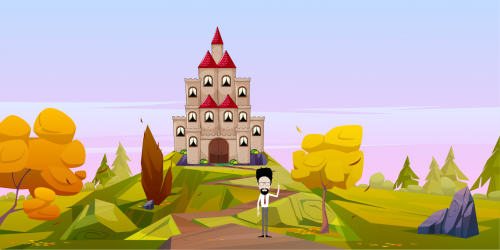
Content
- All blog articles will be updated in the Learning Technologies category in my blog: 教育技术 Learning Technologies | SciShine
- All badges and other contribution certificates will be accumulated and shown on this page:My Accomplishments at WSSG | SciShine
Let’s Game!
I registered Dr. Danielle Oprean’s Designing Games for Learning in the Fall semester of 2023, the first year of my Ph.D. program at the School of Information Science and Learning Technologies in the University of Missouri. Dr. Oprean is my gaming guide and Arch McGee is my personal advocate.
In my previous learning and working experience, I had a limited understanding of the relationships between games and learning. This is my first formal chance to learn games very seriously since “games” in my mind is the opposite word of “learning.” I will record my takeaways from the course and show my learning progression for the coming months. This course opened a brand-new door for me to Game-based Learning (GBL). To most of my classmates, it might be a small step, but to me, it is my giant leap to GBL.
During this journey, I will broaden and enhance my knowledge and competencies of GBL with conducting rotational practices:
Reading/Play (Play)
Knowledge Challenges (Analyze)
Discussion Board (Commune)
Practice Assignments (Adapt)
Blog Posts (Design)
Level Assignments (Create)

My VR Teaching Experience
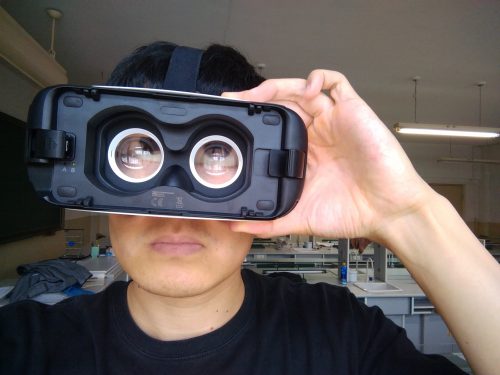
VR (Virtual Reality) was still a fancy name in 2015, especially in K-12 school settings. When I had a chance to use Oculus Rift to teach scientific knowledge in my class, I felt excited and lucky. The first taste of this new staff was an open course to show the availabilities of using VR in everyday instructions. Many observers had limited knowledge about VR, as well as most of my students. So, I used some time to introduce the background of the theory and functions of the Oculus Rift in the beginning. Then, I led all the participants to try some easy softwares to familiarize themselves with the equipment.
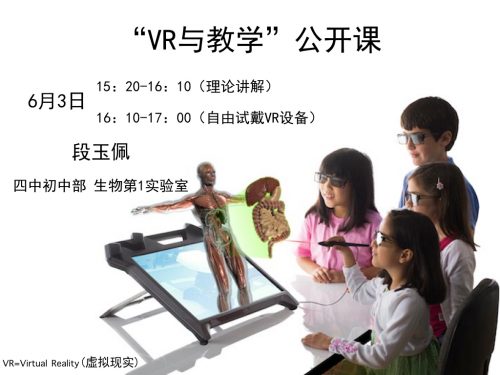
The first open course received a few positive feedback, meanwhile some concerns about the reality of using VR in daily instructions had also been raised, and soon there came the second one, Voyage in Human Body.

I invited the learners, including students and teachers to use their recent learnings in my biology class to do free exploration using Oculus Rift, then explain the phenomena they experienced. Finish the handout by themselves to reach the instructional objectives. The learners were fascinated by both the hardware and software. Some students who are short of learning passion even would like to try and ask more questions about human body structure and functions than usual. VR had the potential to diliver individual instructions.
After the two open courses. I designed and recorded some VR programs. One of them was The Flowers in Beihai Park. If you have VR glasses, you can try it.
There is a lot of potential hidden in instruction with using VR. More professional research and practical reflections need to be done in this area.
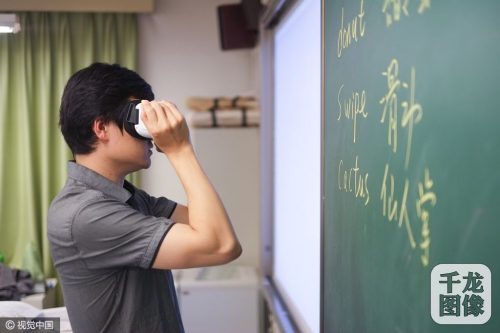
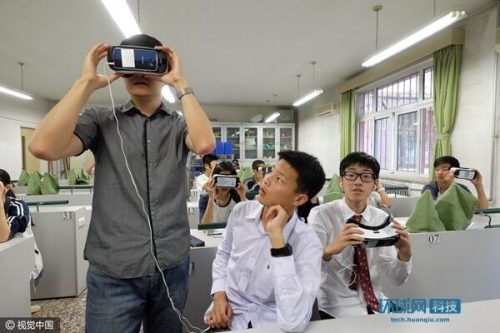
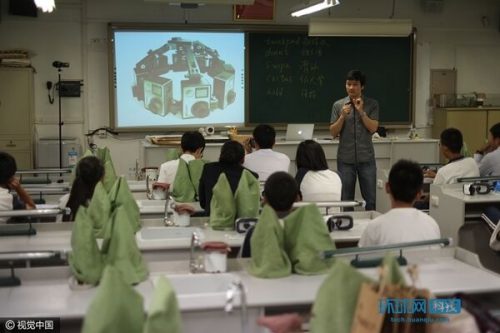
References:
- http://tech.cnr.cn/techit/20160606/t20160606_522327925.shtml
- https://tech.huanqiu.com/gallery/9CaKrnQhtDT
- https://item.btime.com/378v4kal4ou909pqk8lcp1rgvho
How to Assist Online Instructors in K-12 Education in China 如何辅助中国K-12学校教师实施在线教育
How to Assist Online Instructors in K-12 Education in China
Yupei Duan
Curriculum Center, Future Leadership Academy, Hai Nan, China
School of Information and Learning Technology, University of Missouri, Missouri, The USA
December 12, 2020
How to Assist Online Instructors in K-12 Education in China
Background and Significance of the Research
Carliner and Shank (2008) have summarized four key challenges of e-learning: Organizational Barriers, Pedagogical, Technical and Financial Issues. China is faced with most of these issues, together with some unique challenges (Y. Wang et al., 2018a). Teachers are vital component in education. Online teachers have a variety of roles they need to play, such as: evaluator, administrator, technologist, advisor/counselor, researcher, etc. and they should be equipped with multiple competencies (Baran et al., 2011). It is critical to prepare and support teachers for online teaching so that they know what to expect and how to establish their online teacher persona through online pedagogies, and also develop positive attitudes towards online teaching. By incorporating collaborative work groups, community building, and group discussions into professional development programs, and sustaining their continuity, teachers will have an opportunity to participate in communities of practice and transform their teaching by socially constructing their knowledge and practices (King, 2002).
The COVID-19 affected the whole world a lot. It was a test for the online education in different countries and districts. During the pandemic period, educators and students had to rely on online education to continue schoolings. The development of Online education in China has been constrained by a lot of limitations. Zhanyuan Du, Vice Minister of Education of China, has stressed that there are three key tasks for e-learning development in China: “teachers’ and students’ acknowledgement of e-learning, teachers’ capacity for integrating ICT with daily instructions, and production of sufficient quality resources so that teachers can focus on pedagogical design (中国教育信息化要解决三问题 – 信息化动态 – 中国教育信息化网, 2015).” While more teachers in China are equipped with the basic Information and Communication Technology (ICT) knowledge and skills and get more knowledge about e-learning, the situation of China’s online education might be better. Since ICT is the foundation of online education, teachers who have more abilities about ICT, who could understand the value and usability of online education, who might integrate ICT more in their daily instructions, and who have more possibilities to yield higher-quality online education production.
Problem Statement
This study aims to explore the experiences, suggestions and standards for assisting online instructors to present higher-quality online instructions drawing mostly from the USA, and introduces some useful strategies from institutes who have been endeavoring to establish high standard online education from all over the world to China’s K-12 schools. With practice and comparation to make the most suitable one for China.
With collecting data from practices in some volunteer Chinese K-12 schools, the researcher wants to finish the first draft of Chinese K-12 online education standards and design some useful in-service or pre-service trainings for Chinese online instructors.
Purpose of the Study
The researcher will focus on the online education at China’ K-12 school context among the different types of online education. The COVID-19 pandemic has made all stake holders at schools: parents, students, educators and administrators to realize the value of high quality of online education much better. There are a lot of startups and E-giant companies are seizing the profit of online education by inventing new Apps and platforms, and establishing online courses and commercial training programs to the K-12 students in China. There has been so much growth in this market that the government has issued a lot of regulations to control them(Growth of China’s Online Education Industry Spurs New Regulations, 2020) . The fast increase need of high-quality online education from learners are apparent. Yet the supportive standards for evaluating and establishing online education were limited in China. On the other hand. If the students can get high quality online education from their own school with their familiar educators and yield more learning outcomes, why they need to pay extra money out of school? The more expansive thing for the learners is not money but time.
The author could not find formal instructions to assist teachers about how to do high-quality online teaching in Chinese. However, there is a great deal of information in English. What kinds of online teaching standards, teaching strategies suggestions the Chinese online educators need currently? What kinds of online learning tips Chinese learners should be aware of to yield higher online learning outcomes? Is the information workable, effective and efficient? The mixed-methods will be used during the research.
Literature Review
Sources deemed most relevant to the topics were selected for further analysis; preference was made to recent (published during 1999-2020) articles, but older sources were included especially the classical ones which contain impressive points and suggestions. These articles were searched and collected through google scholar and University of Missouri Columbia Libraries, utilizing the following search tactics: K-12, Online Education, Online Teaching, Standards, etc.
Online Education Definition and its Development in China
E-learning, also known as online learning, digital learning or computer-based learning, can be defined as education provided on digital devices that support learning (Clark & Mayer, 2011). The use of Information and Communication Technology (ICT) in education has given rise to diversified pedagogical models and methods, including networked learning, multimedia education, online and open education, and blended learning. In China, the term ‘ICT in Education’ is used interchangeably with the more general term ‘e-learning’ (Y. Wang et al., 2018b). With rapid economic development, China is becoming able to provide better infrastructure and other necessary conditions for schools (e.g. more high-quality computer labs, more learning soft wares and more online learning strategies), E-learning is believed to be a promising approach since it offers students ways to interact with experienced teachers or professors (Q. Wang et al., 2009).
In the first four years after 1996, the growth of online schools (at China) was fast, and the concepts of e-learning and online school were formulated. In the following four-year adjusting stage, the number of online schools decreased remarkably as some investors and managers of over-emphasized on financial gains but while ignoring Standards of web-based education. At the steady stage(2005-2009), managers and teachers have paid more attention to the educational role of online schools. They have developed better understanding and an improved model of cooperation. For example, one of the styles of cooperation is named “Two Instructors Cooperation Model” which means while one instructor teaching virtually, there is the other instructor (teaching assistant) working in the physical classroom to direct the students to dig more from the online instructions.
There are three models of running K12 online schools in China. Some online schools are run by a consortium of the government, or by an enterprise or a school alone. Most online schools in China are supported by private enterprises (Q. Wang et al., 2009). Online education, also known as virtual or cyber schooling, is a formal of distance education that uses the Internet and Computer technologies to connect teachers and students and deliver curriculum. Students may also communicate online with their classmates, students in other schools around the world and experts to whom they might otherwise not have access. Online learning may take the form of a single course for a student who accesses that course while sitting in a physical school, or it may replace the physical school for most or all of a student’s courses (Watson & Gemin, 2010).
K12 Online Education Market in China
In 1996, China’s first primary and secondary education website (online school), 101 online school, was established. Four year later, the Beijing No.4 Online School was built. The education at this time was mainly based on academic education, and the form was mostly based on a single form such as text mail. The interactive form was not strong, mainly based on traditional education methods (Chen et al., 2009). Students and online teachers could only use text to do interactive activities. There were no other choices for the online learners in China who wanted to get higher quality K-12 online instructions. The reasonable online instructions should be more interactive which requires the online instructors to communicate with the learners closely and share the feedback of the learners’ information with their parents frequently. Online instructors need to foster the online learners’ enthusiasm and interest in learning. It is also the online instructors’ duty to embed more technique tools and enhance their skills to improve their online teachings (Hu & Meyen, 2013).
Both Beijing 101 school and Beijing No.4 School are two of best high-schools in Beijing, China. (The author worked at Beijing No.4 School for ten years and has learnt that there were very few requirements for online instructors who taught at Beijing No.4 Online School.) In the past decade, online education market in China changed so fast. More and more companies like “Gen Shei Xue”, “Hao Wei Lai”, “New Oriental School”, etc. have stepped into the K-12 training market to set very high standard and expectations of online education. The parents would prefer to pay more money to buy better online education from these kinds of companies for they keep improving their online teaching strategies (Huang & Hong, 2017).
Quality of Online Teaching
To help China’s K-12 online instructors improve is the first step to get high-quality K-12 online education. Without clear and specific goals, the online instructors will lose themselves and cannot improve their online instructions highly (Baran et al., 2011). There are a lot of mature online teaching standards and suggestions written in English world which might be meaningful for Chinese colleagues.
In 2010, an international quality standard for e‐learning programs – “Open ECBCheck” – was officially released. ECBCheck is an accreditation and quality improvement scheme for e‐learning programs which supports organizations in measuring the success of their programs and allows for continuous improvement though peer collaboration. It was developed through an innovative and participative process involving more than 40 international, regional and national capacity‐development organizations (Open ECBCheck – Quality Improvement Scheme for E-Learning Programmes | GIZ Global Campus 21, n.d.).
In the standards (E-Learning Methodologies – A Guide for Designing and Developing e-Learning Courses, n.d., p. 14), the quality of an e-learning course is enhanced by: (1) Learner-centered content: E-learning curricula should be relevant and specific to learners’ needs, roles and responsibilities in professional life. Skills, knowledge and information should be provided to this end. (2) Granularity: E-learning content should be segmented to facilitate assimilation of new knowledge and to allow flexible scheduling of time for learning. (3) Engaging content: Instructional methods and techniques should be used creatively to develop an engaging and motivating learning experience. (4) Interactivity: Frequent learner interaction is needed to sustain attention and promote learning. (5) Personalization: Self-paced courses should be customizable to reflect learners’ interests and needs; in instructor-led courses, tutors and facilitators should be able to follow the learners’ progress and performance individually.
The third edition of American National Standards for Quality Online Teaching purposely provided the K-12 online and blended learning community with an updated set of openly licensed standards to help evaluate and improve online courses, online teaching and online programs with the contribution from another two documents known collectively as the : American National Standards for Quality Online Programs and American National Standards for Quality Online Courses (Powell et al., n.d. P5). The set of standards served to inform the team, allowing them to make community and research supported updates. Subsequently, author took time to evaluate each standard and found they met the following criteria: measurable, valid, complete, relevant, and specific. Chinese online instructors can check the standards with clear definitions and explanations with examples to transfer to their online teaching actions.
Besides the formal standards which can help online instructors clarify their to-do lists about how to provide appropriate online instructions, the suggestions from some institutes are useful to bring more insights to improve online education for K-12 online instructors, especially during the COVID-19 pandemic spread period. The Danielson Group Remote Teaching Guide (Danielson Group Remote Teaching Guide.Pdf, n.d.) is one of them. Each academic year, the subject teachers in the author’ school will provide at least two class periods to be observed by the members in Academic Department to show their teaching abilities which we name them formal observations. The Academic Department members will use the Framework (Danielson, 2014) for teaching from the Danielson group for assessing subject teachers’ formal observations. The Remote Teaching guide is reflected in Framework for Teaching which shared eight suggestions to online instructors from knowing and valuing the online learners to build responsive learning environment, then to engaging students in learning. The online instructors will find more valuable strategies and tips to miss overwhelming when they conduct online instruction if they delve into deeper with reading and practice the suggestions in the guide.
Trainings for Enhancing Instructors’ Online Teaching Competencies
As online learning grows in K-12, the need to prepare quality online instructors increases (Borup & Evmenova, 2019). There are a lot of barriers the quality online K-12 instructors need to learn to cross. The barriers between the good online K-12 classroom and low efficiency which were listed two decades ago still affect online instructors. The barriers are: Academic, Fiscal, Geographic, Governance, Labor-Management, Legal, Student support, Technical, Cultural (Berge & Mrozowski, 1999). If the teachers did not learn how to face to the barriers when they were in the college, they may get some in-service professional development (PD) programs to help them add this part of competencies. If the PD programs are held fluently, the learners may improve their online teaching skills and knowledge (first-order barriers to change) and nurturing positive attitudes and dispositions (second-order barriers to change) (Borup & Evmenova, 2019). The online PD itself is a good model to show the learners about what is a good online course you need to learn to conduct. There are a lot of difference between face-to-face teaching and online teaching. Barbour (2012) found that the different competencies were required to deliver high quality online teaching. Even the experienced face-to-face teachers might fail to present quality online instructions. The effective PD program will deliver content and assignment proved effective at increasing faculty members’ knowledge and skills, but it was the course delivery and the opportunity to learn as an online student that appeared to most impact faculty members’ attitudes and perceptions of what was possible in online learning environments. In other words, the method was just as important as the message. When designing professional development courses, universities (or other departments) not only need to consider what will be learned but how it will be learned. If courses do not model effective online instruction, they run the risk of increasing faculty members’ skills without improving their practice (Borup & Evmenova, 2019). There are some successful PDs like Borup and Evemenonva’s PD ( 2019) which covers the following topics: (1) course design and development, (2) assessment and feedback, (3) student collaboration, (4) discussions, and (5) presence and support.
Methodology
- Mixed-Method
The mixed-methods will be used. While conducting a bibliometrics focus on online teaching, hybrid teaching, online education standards, etc. The information will be concluded and compared to be selected as suggestions for assisting Chinese K-12 online teachers in their trainings and in-service instructions. Then, some questionnaires will be distributed to online educators, learners and parents to get their feedback about online instructions. The data will be used by qualitative and quantitative methods to test which suggestions or standards will be useful to the online instruction stake holders.
- Research Model
- Brief rationale for the selected approach
With the qualitative and quantitative research, the researcher can collect more divisions of feedbacks about online instructions from online teachers, learners and parents. The aims of the research are figuring out the most reasonable and workable assistance to Chinese K-12 online instructors. We hope to stand on the giant’s shoulder and face to the reality of China’s K-12 online education to compose two documents: Chinese Online Instruction Standards, and Chinese Online Instruction Suggestions, besides that, we will develop PD programs to assist Chinese K-12 online instructors. We wish they are reasonable and meet China’s online instructors’ expectations. Due to the different cultural and historic backgrounds in China and other countries or districts, the experiences from others must be improved to be embedded in Chinese education context. That will be the researcher’s following research aims.
Variables
Independent variables: online teaching standards with using or not; online teaching suggestions with delivering or not; Weather took part in the PD for assisting online instructors developed by researcher.
Dependent variables: Online teachers’ instructional performance scores with using online teaching standards to evaluate; Teachers’ online instruction materials establishing time using before and after training; Teachers’ degree of satisfaction of online instruction before and after training; Online learners’ degree of satisfaction of online education; Parents’ degree of satisfaction with online education.
Sample
170 online learners from primary school, secondary school and high school.
50 online teachers from Future Leadership Academy (a private K-12 school).
100 college students who want to be teachers after graduation at Beijing Normal University.
100 in-service teachers in China K-12 schools.
100 parents whose kids are having online courses.
Data Collection
Qualitative data: Survey, interviews
Quantitative data: Survey, formal observations, data record on learning management system, interviews
Ethical Considerations
Students and parents’ privacy protection. The data from the students and parents will be ONLY used for research and will not be open to others without erasing the names of the students and parents.
Data Analysis
Correlation Analysis using SPSS
Timeline
February, 2021. Preparation period:
In the coming school-wide professional development program, the research proposal will be informed.
February, 2021. Transition period:
the online instructors will be required to having online teaching trainings. The suggestions and strategies will be shared with them as well.
March, 2021. Orientation period:
- The online learners and parents will be delivered online education orientation with introducing more details of online courses and suggestions for online learnings.
- The online instructors will be directed to have online trainings with sharing more online teaching standards.
April-June 2021. Formal online instructions conduction
- Data collection.
- Survey
- Interviews to teachers, students and parents.
July 2021. Data analysis and reaching a conclusion
References
Baran, E., Correia, A.-P., & Thompson, A. (2011). Transforming online teaching practice: Critical analysis of the literature on the roles and competencies of online teachers. Distance Education, 32(3), 421–439. https://doi.org/10.1080/01587919.2011.610293
Barbour, M. k. (2012). Training teachers for a virtual school system: A call to action. In Developing Technology-Rich Teacher Education Programs: Key Issues. IGI Global.
Berge, Z. L., & Mrozowski, S. E. (1999). Barriers to Online Teaching in Elementary, Secondary, and Teacher Education. https://doi.org/10.21432/T2P59B
Borup, J., & Evmenova, A. (2019). The Effectiveness of Professional Development in Overcoming Obstacles to Effective Online Instruction in a College of Education. Online Learning, 23(2), Article 2. https://doi.org/10.24059/olj.v23i2.1468
Carliner, S., & Shank, P. (2008). The e-learning handbook: Past promises, present challenges (MU Ellis Library). Pfeiffer.
Chen, L., Wang, N., & Qiao, A. (2009). K12 online school practice in China. Campus-Wide Information Systems, 26(2), 137–144. https://doi.org/10.1108/10650740910946864
Clark, R. C., & Mayer, R. E. (2011). E-learning and the science of instruction: Proven guidelines for consumers and designers of multimedia learning (MU Online; 3rd ed.). Pfeiffer.
Danielson, C. (2014). The framework for teaching: Evaluation instrument.
Danielson Group Remote Teaching Guide.pdf. (n.d.).
E-learning methodologies—A guide for designing and developing e-learning courses. (n.d.). 141.
Growth of China’s Online Education Industry Spurs New Regulations. (2020, March 12). China Briefing News. https://www.china-briefing.com/news/growth-chinas-online-education-industry-spurs-new-regulations/
Hu, X. C., & Meyen, E. L. (2013). A Comparison of Student and Instructor Preferences for Design and Pedagogy Features in Postsecondary Online Courses. In Curriculum, Learning, and Teaching Advancements in Online Education. IGI Global.
Huang, X., & Hong, W. (2017). Live Streaming Teaching Applied in Real English Classroom. DEStech Transactions on Social Science, Education and Human Science, 0(aems), Article aems. https://doi.org/10.12783/dtssehs/aems2017/8278
King, K. P. (2002). Educational technology professional development as transformative learning opportunities. Computers & Education, 39(3), 283–297. https://doi.org/10.1016/S0360-1315(02)00073-8
Open ECBCheck – Quality improvement scheme for E-Learning programmes | GIZ Global Campus 21. (n.d.). Retrieved October 28, 2020, from https://gc21.giz.de/ibt/var/app/wp342P/1522/index.php/open-ecbcheck/
Powell, A., Oliver, W., Archambault, L., Borup, J., Boyarko, M., Cavanaugh, C., Copeland, R., Day, J., DeRosa-Davis, T., Deschaine, M., Graham, C., Hanson, E., Hernandez, B., Imbrunone, M., Kennedy, K., Consulting, K. K., Kolar-Burden, J., Little, T., Loomis, K., … Online, P. (n.d.). National Standards for Quality Online Teaching. 33.
Wang, Q., Zhu, Z., Chen, L., & Yan, H. (2009). E‐learning in China. Campus-Wide Information Systems, 26(2), 77–81. https://doi.org/10.1108/10650740910946783
Wang, Y., Liu, X., & Zhang, Z. (2018a). An overview of e-learning in China: History, challenges and opportunities. Research in Comparative and International Education, 13(1), 195–210. https://doi.org/10.1177/1745499918763421
Wang, Y., Liu, X., & Zhang, Z. (2018b). An overview of e-learning in China: History, challenges and opportunities. Research in Comparative and International Education, 13(1), 195–210. https://doi.org/10.1177/1745499918763421
Watson, J., & Gemin, B. (n.d.). A Parent’s Guide to Choosing the Right Online Program. 23.
中国教育信息化要解决三问题—信息化动态—中国教育信息化网. (n.d.). Retrieved October 28, 2020, from http://www.ict.edu.cn/news/n2/n20150525_24914.shtml
Read More

